Content
- 1 How to choose chicks when buying?
- 2 Is it better to grow with a hen or in an incubator?
- 3 Conditions of detention
- 4 Food
- 5 How to determine the gender of a chicken: chicken or rooster?
- 6 Methods for determination in poultry farms
- 7 How do you determine your age?
- 8 Diseases of chickens
- 9 Diarrhea in chickens
- 10 Worms
- 11 Disease prevention
- 12 Selection of eggs
- 13 Defective
- 14 Incubation period
From the moment the chickens leave the incubator, a serious test begins for the poultry farmer, because at first they are vulnerable and may die. It is necessary to provide them with good conditions for growth.
When chickens are hatched by a hen, she shifts all these worries onto herself, but this does not work out with piece incubation. Therefore, we will consider how to raise chickens from an incubator, with maximum preservation of the livestock.
Requirements for the conditions of detention 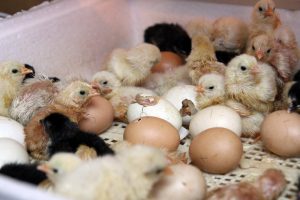
Day-old chicks
Usually at home, the poultry farmer does not have a special brooder for chicks, which automatically maintains optimal conditions of temperature, humidity and lighting.
Therefore, they need to be created independently, and constantly monitor this process in order to notice unwanted changes in time.
For the first few days after incubation, chicks can be kept in crates or cardboard boxes. The room in which they are installed must be protected from precipitation, ventilated and electrified. In it, daily temperature fluctuations are undesirable.
The bottom of the drawer should be covered with a sheet or other non-slip cloth. It is strongly not recommended to use newspapers as bedding. Chicks' fragile legs will move apart, and many of them will receive twine, which will then have to be straightened.
After a week, you can move them into a cage with a dense mesh bottom, which will make cleaning easier.
Small chickens are most demanding on the following parameters of keeping:
- temperature;
- lighting.
They are easy to provide using both specialized equipment and ordinary electrical household appliances. Let's take a closer look at these parameters and how to maintain them.
to contents ↑ Temperature
Newly hatched chicks are characterized by the absence of subcutaneous fat and the presence of only a weak fluff, which is not able to provide them with heat in full. Therefore, for the first 5 days, they should be kept at a constantly high temperature of 29-30 degrees. Usually, it is not so hot around the clock, even in summer, so you will have to use additional heat sources.
To do this, the box with chickens can be moved to the radiator or convector if the birth took place in winter.During warmer months, you can use other sources such as portable electric heaters, special infrared lamps, or ordinary incandescent bulbs.
It should be borne in mind that the need to maintain the temperature will be acute for a long time, so energy costs will turn out to be significant. It is better to choose a heat source that is cheaper to maintain.
You need to plan in advance how to raise chickens, and how much it will incur. So it turns out to calculate the optimal number of livestock to cover the cost of their initial maintenance and feeding.
Infrared lamps are highly efficient, so they are specially produced for heating animals. If you install a lamp, no matter what type, then it can be connected through a thermostat, such as used in an incubator.
When he is not there, the lamp is installed above the box where the chickens are kept, at a distance of 30-40 cm. A thermometer is placed on the floor for a few minutes and the temperature is measured. If it is too high, then the lamp should be raised higher, and if it is low, then on the contrary, it should be brought closer.
You should not worry that the right temperature is only under the lamp, and the corners of the box are cool, since the chicks will rest in the warmest place and will not feel discomfort. If there are too many of them and they all do not fit, then the number of lamps should be added.
From the sixth day, you can gradually lower the temperature by one degree every few days. By the age of one month, the birds will be fully adapted to keeping at + 18-20, which will allow them to refuse additional heating.
back to content ↑ Lighting 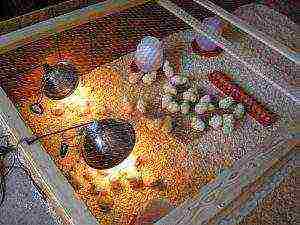
Correct lighting
For the first seven days of hatchery life, it is important for chicks to be under constant light. From the second week to the end of the third, daylight hours should be gradually increased to 9 hours.
And only with the approach of maturity, starting from the fourth month, the duration is gradually increased and brought under the norm of adults.
If a timer is not available that would automatically control the duration of the lighting, then this will have to be done manually. It is very inconvenient to wake up at night to turn off the lamp for several hours and then turn it on again.
Therefore, many poultry farmers start to do a night regimen for small chicks during the day. At first, the lighting break is very small, so it is really easier to do it when the owner is awake.
Gradually, you can shift the shutdown schedule, and adjust it for natural conditions.
back to content ↑ Feeding
Having dealt with the conditions of detention, you can move on to an equally important point, namely, how to feed the chickens after the incubator. Depending on the age of the chicks, the quality and quantity of feed that he should consume per day is different.
To raise chicks effectively, you need to provide them with good nutrition for their age. Consider popular feeding patterns.
back to contents ↑ Immediately after the incubator 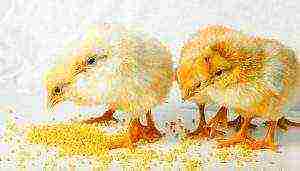
Incubator chicks
On the first day, as soon as the chicks enter the brooder or crate, they need to ensure they have clean water. It is best to use a balanced pelleted compound feed as a feed.
It will not be difficult to choose it, since it will be written on the bag or packaging that it is intended specifically for day-old chicks.
Even poultry farmers, who are not supporters of compound feed, and solely give their poultry grain and homemade mash, recognize that factory-made balanced food in the first days of a chicken's life is better.
Small amounts of food are poured onto the floor. On the second or third day, you can start using specialized feeders and troughs.
Corn grits can also be used as the first feed, which also gives good results in raising the health of birds, but is inferior to compound feed.
Small chickens do not eat much after the incubator, and very few grains under their feet are enough to feed them. But at first they must be constantly present.
back to contents ↑ Second day
Those poultry farmers who refuse compound feed, from the second day, in addition to corn, introduce a mixture of other cereals such as:
- semolina;
- wheat;
- egg;
- millet.
You can provide the chicks with a large supply of food for half a day at once, or feed them every 2 hours. If there are a lot of chickens, then the food poured under their feet will quickly mix with the secretions, making it dangerous to eat.
Therefore, if the content is dense, it is better to add small amounts of food. Also, raising chickens will be more efficient if you start feeding them cottage cheese. This will provide them with calcium and an easily digestible protein.
back to contents ↑ First week
Drinking and feeding in the first week is almost the same as on the second day. From the third day onwards, feed portions should be increased so that the chick can eat about 10 grams of feed per day. The frequency of adding food can be reduced and brought up to 8 times by the end of the week.
You should start adding herbs like stinging nettle or dandelion. The herb must be finely chopped and given in a mixture with cereals or cottage cheese. By the end of the week, you can add onions and grated carrots.
Back to contents ↑ Second week
From the second week, caring for the chicks becomes a little easier. They will already get stronger enough and become more independent. Food can be brought to them already 6 times a day.
Its amount should be increased at the rate of 15-20 grams per day for each. At this time, the birds eat the same as in the first week, but only in large quantities. You can no longer chop the greens as finely as in the first days.
back to contents ↑ Third week
With the beginning of the week, you can refuse night feeding, and spend it only 4 times. From this point on, raising chickens is more like keeping ordinary chickens. You can stop feeding with cottage cheese. A mash should be introduced into the diet, which is consumed by mature layers. The daily food intake is 25-35 grams for each individual.
Gradually, the feeding conditions of the chickens become the same as those of adults. It is necessary to ensure that the fraction of the feed fits into their beak. Whole grains can be fed when the chicks are 3-4 months old.
back to content ↑ Growth control
To check the effectiveness of your feeding scheme, you need to periodically weigh the chicks and compare their weight values with the tabular standard for this breed. This picture shows a table for different breeds. So a laying hen chick that has received good care and feeding by the age of ten days should weigh 60 grams.
Chickens and hens weight table by day
Over the next 10 days, it should practically double its mass. The established weight of laying hens according to the table is an indicator of the correctness of the content. If the mass of chicks is rejected downward, then this means that mistakes have been made that need to be corrected immediately, because the poor development of layers in childhood will affect their productivity in adulthood. Therefore, the account goes on here day by day, and it is impossible to delay identifying the reasons.
back to contents ↑ Walking and sanitizing cages
From time to time, chicks need to be taken out to fresh air if the outside temperature allows it. Sunlight is beneficial for their health and promotes the production of vitamin D. This also causes the death of harmful bacteria that develop in the chick box.
If the weather is not conducive to walking, then they can not be arranged until the chickens are two months old. In the event of frost or high dampness, this can be postponed for an even longer period, since the absence of the sun will affect the body of young birds less negatively than cold.
You need to know how to care for your chicks to ensure they grow normally.But do not forget that you also need to keep their cage or box clean. You can clean up as soon as it gets dirty, but do not start this process. Ignoring this rule leads to the appearance of intestinal diseases and mass deaths.
Thus, having considered the main aspects of how to keep chickens after the incubator, and strict adherence to them, you can grow your livestock with practically no losses.
back to content ↑ Video
← Previous article We make nests and perches for laying hens with our own hands: 3 ways Next article → How to keep laying hens and broilers together: rules and possible problems
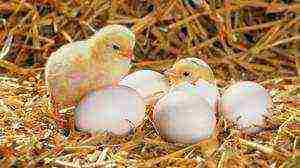 Some summer residents are afraid to have small chickens because it is a very responsible and troublesome job. Small chicks require special conditions of detention. It is very important to maintain the temperature of the chicks, feed them properly and keep them in the right conditions. Keeping chickens after an incubator is not easy, but if you try, the result will delight the owner.
Some summer residents are afraid to have small chickens because it is a very responsible and troublesome job. Small chicks require special conditions of detention. It is very important to maintain the temperature of the chicks, feed them properly and keep them in the right conditions. Keeping chickens after an incubator is not easy, but if you try, the result will delight the owner.
How to choose a good chicken
Not all hatchery chicks are in excellent health. And the cost of an unhealthy chicken would be too high. Therefore, you need to remember some criteria by which you can choose a good young growth for your chicken coop:
- a healthy chick should confidently keep on its feet;
- his movements are clear and fast;
- the chicken instantly reacts to emerging sounds and flickering of light;
- the chick should have a developed pecking instinct;
- the abdomen should be soft and taut, and the umbilical cord should be completely healed;
- pay attention to the cleanliness of the cloaca;
- the chick's eyes should be sufficiently prominent and shiny, and the wings should fit snugly against the body.
How to care for chickens in the first days of life
The first weeks of life are considered the most dangerous period for the life and health of chickens. At this time, they require special attention to themselves and should be kept in optimal conditions. A caring owner must provide them with the best possible care at home:
- the required air temperature in the room;
- good, balanced nutrition;
- constant access to fresh and clean water;
- proper housing conditions (chicks should always be clean and warm).
 Chicks that have dried out should be transplanted from the incubator directly below the hen. If you do not have such a chicken, then prepare a cardboard or wood box for them in advance. It should be of such a size that all chicks fit there and they have room to move. In such "houses" they quickly adapt and get stronger. The box should be kept in a dry and warm place so that future hens feel good.
Chicks that have dried out should be transplanted from the incubator directly below the hen. If you do not have such a chicken, then prepare a cardboard or wood box for them in advance. It should be of such a size that all chicks fit there and they have room to move. In such "houses" they quickly adapt and get stronger. The box should be kept in a dry and warm place so that future hens feel good.
Put a cloth folded in several layers at the bottom of the box. Some summer residents lay a newspaper, but this cannot be done. A slippery surface can dislocate or break a weak leg.
Where to relocate
When the first days of life are over, the chickens have matured long ago, they can be moved to the chicken house. It is necessary to prepare this room in advance. To prevent the development of infections, you must maintain a clean, warm and dry house at all times. So, here are the basic requirements that must be met regarding the premises:
- complete disinfection of the room should be carried out;
- you need to ensure complete safety against cats and rats;
- air humidity should not exceed 70%;
- chickens should be spacious, so there should not be more than 12 heads on one square meter;
- the floor should be covered with hay.
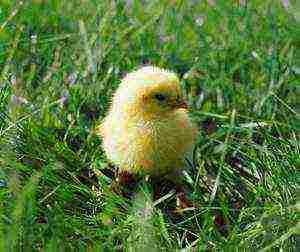 For the first walk, chicks can be taken out within a week after birth. On the first day, they should walk no more than one and a half hours, and then you can increase the time spent in the fresh air. When the chickens get used to the outdoors, they can spend the whole day in an equipped pen. It should be made of netting that will keep the fugitives out of the paddock and keep the bait hunters out.As you know, the sun's rays are a source of vitamin D. When receiving it, chickens undergo a preventive course against rickets.
For the first walk, chicks can be taken out within a week after birth. On the first day, they should walk no more than one and a half hours, and then you can increase the time spent in the fresh air. When the chickens get used to the outdoors, they can spend the whole day in an equipped pen. It should be made of netting that will keep the fugitives out of the paddock and keep the bait hunters out.As you know, the sun's rays are a source of vitamin D. When receiving it, chickens undergo a preventive course against rickets.
Optimum temperature for chicks
Caring for young animals also includes providing the right temperature and light. In the first month of life, the chicks of chickens have practically no thermoregulation, so the owner must carefully monitor the temperature in the place where the chicks are. On the first day after the incubator, it should keep at around +35 degreesin. Further, one can gradually reduce to 30 degrees.
Experienced farmers use conventional incandescent bulbs to heat the box or chicken house. They should be located at a height of forty centimeters from the floor... Chicks should be able to stand under the lamp at any time if they are frozen or hide from its rays if they become too hot. The temperature should be monitored for the first month and a half.
In the place where the chickens live, there must be a thermometer. It should be hung ten centimeters above the floor. If its initial indicator should be +35 degrees, then by the end of the second month of life, +21 degrees will be enough for the chicks.
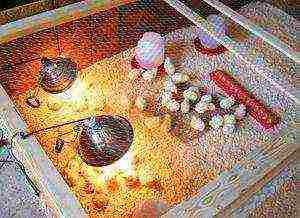 It is very simple to determine whether young animals are comfortable living. It is enough to observe their behavior for a while. Chickens, which are cold, try to stick together, move a little, huddle together. This condition leads to illness and even death. And if they frolic, have a good appetite, it means that they like everything and the owner can be calm.
It is very simple to determine whether young animals are comfortable living. It is enough to observe their behavior for a while. Chickens, which are cold, try to stick together, move a little, huddle together. This condition leads to illness and even death. And if they frolic, have a good appetite, it means that they like everything and the owner can be calm.
Light is another important factor. In the early days, chicks need constant lighting.... Later, you can turn off the lamp for 15 minutes. The older the young grows, the shorter their daylight hours should be. Light is an excellent growth stimulator for chicks.
How to feed chickens at home
What else does the correct development of chickens depend on? From food, of course. The pecking instinct is developed in them from the very birth, so there is no need to bottle feed them. Their menu should include the following products:
- in the first four days of life, chicks of chickens should eat boiled chicken egg, cut into small pieces;
- on the second day add to the diet boiled millet... At first in small quantities, and then it becomes a staple food;
- you can also give corn and wheat grits;
- it is better to refrain from adding barley and oats to food. These grains have a negative effect on the digestive tract of young animals;
- on the 3rd day can be added to food feed mixtures, but they must be of sufficient quality;
- many vitamins are found in greens: nettles, green onions, alfalfa, carrots and clover... The greens should be finely chopped so that they do not get stuck anywhere in the young chicken;
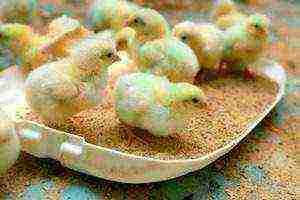 should also be included in the menu powdered milk and cottage cheese;
should also be included in the menu powdered milk and cottage cheese;- chickens need constant availability gravel near the feeder. They need it for normal digestion. Chickens can be given gravel as early as the fourth day;
- meat and bone meal Is another must-have in the chicken nutrition chain. If it is absent, it can be replaced by earthworms;
- a very valuable supplement is considered shell rockwhich contains a lot of calcium;
- many poultry farmers recommend adding to the mash wood ash at the rate of 0.6 grams of product per chick.
For the first ten days, chickens should receive feed every two hours, then 6 times a day, and then no more than four. It is recommended to scatter feed in the places where they are located. Food in the trough can cause severe crush. To make sure that the chicks are full, watch them. Well-fed chickens go to bed after eating.
If among the young you notice that some chicks are less active and eat poorly, then it is better to place them in a separate box. There they will be able to grow stronger and quickly catch up with their fellows.And in a common box, they can simply be trampled.
Chickens always have fresh boiled water must be poured... A saucer and a jar turned upside down are used as a drinker. Thus, the water constantly fills the saucer and does not get fluff into it. It is important that the water is always fresh and the drinker is clean.
> How to grow broilers
The keeping of broilers has a number of differences from the keeping of hens of egg breeds. Broilers grow very quickly and can weigh up to 1.5 kilograms within two months.
There are two ways to raise broilers, but experienced farmers have chosen one for themselves, the best - intensive growing:
- from birth to slaughter, broilers are kept in small cages of 12 individuals per square meter. This is necessary to restrict movement and quickly gain mass;
- the feeder should be located in such a way that three centimeters of area are available for one head;
- throughout the life of individuals, they must be kept in the same temperature regime;
- the first five days of chickens' life, the lamp in their cage should not go out. Then, until 22 days, the lighting time is gradually reduced by several minutes every day. As a result, their daylight hours should be 18 hours;
- you need to feed these chickens with a special balanced compound feed. For broilers to gain weight quickly, they must have 24/7 access to food.
> Raising chicks under hens
Raising young chicks at home under a hen is the safest way to raise healthy chicks. A responsible laying hen will teach the chicks everything she knows herself. She will be able to show them how to get food and protect themselves from enemies. Keeping chickens with laying hens greatly facilitates the fate of the owner.
If you decide to give the chicken chicks from the incubator, then it is better to do it at night. After all, she may not accept chickens, therefore, on the first night, while the mother sits on the eggs, several day-old chicks are placed under her. In the morning, the owner watches to see if she has accepted them. If the result is positive, you can put the rest on the next night.
In early spring, a hen can heat up to 15 chicks, and in summer, up to 20 chicks can be placed. The laying hen will now provide care for the chickens, and the owner can only provide her with optimal conditions for raising the young.
Chicken meat, chicken eggs are healthy foods that everyone has on the table. Therefore, raising chickens is not only a profitable business, but also a payback. However, before deciding to start breeding chickens, it is still worthwhile to study in detail all the nuances of breeding chickens, keeping and growing.
In this article we will talk about raising chickens at home for beginners, learn how to raise chickens, why chickens vilify, what to give broilers for diarrhea and other pressing issues.
How to choose chicks when buying?
Raising chickens from an incubator at home is a profitable business, because in addition to meat and eggs, bird feathers and manure can be successfully used as an organic fertilizer. But in order for this business to be beneficial, it is necessary to choose the right chickens.
The best time to buy chickens is April-May.... It is advisable to purchase day old chicks. It is better to buy chicks at poultry farms, because in these places there are guarantees that the individuals are healthy and strong. However, in order to choose chickens, you need to know the nuances of selection depending on the age of the individuals.
Daily
In order not to be mistaken and to acquire healthy day old chicks during the purchase, you need to pay attention to a number of criteria for the appearance of young individuals:
- The chick must be dryhealthy and active;
- The down should not be sticky. In appearance, he must be fluffy, free from dirt and foreign debris;
- At the day-old calves at the time of sale the umbilical cord must be overgrown;
- It is imperative to carefully examine the umbilical cord.If there are secretions on it, then this young growth is not worth buying. Discharge is the first sign of an infectious disease;
- The cloaca must be clean, pink in color with a moist texture. There should be no dirt, traces of droppings on it;
- The chicks should have reaction to sounds;
- The back should be straight;
- The head should be straight;
- Smooth and correct beak with a pigmented structure.
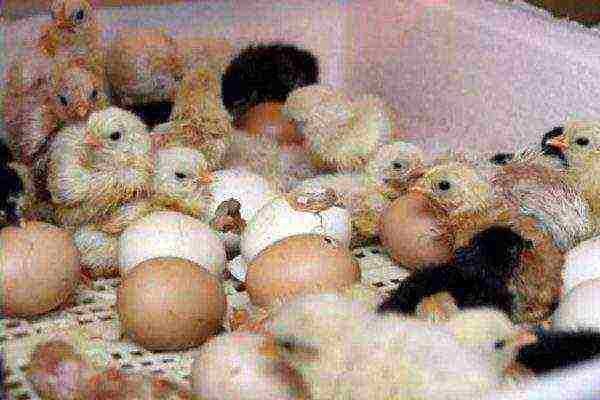 Newly hatched broiler chicks
Newly hatched broiler chicks
Weekly
Sometimes poultry farmers buy one week old chicks to save money and time. However, this is not always the correct and correct decision. Young individuals at this age are susceptible to diseases. In addition, their body is weak and weak.
But if you do decide to purchase weekly chickens, you should consider the following selection criteria:
- Individuals must be active and healthy;
- The plumage should be fluffy without dirt, traces of droppings;
- The abdomen should be soft to the touch;
- The head is straight, proportional;
- The beak is straight with a pigmented structure;
- Good response to sounds;
- Should already be worked out pecking reflex;
- The wings should be tightly attached to the body;
- The cloaca should be clean, pink and free from dirt and secretions.
Monthly
Chicks one month old are rarely purchased for divorce. Still, some farmers believe that during this period, individuals survive better and they have developed immunity to infectious diseases... Perhaps this is so, but you should not trust this criterion. Sometimes monthly individuals get sick much more often.
In any case, the criteria for choosing monthly chicks are the same:
- Activity and mobility;
- Good response to sounds;
- Plumage - fluffy, without dirt, droppings, with a smooth structure;
- The abdomen should have a soft texture to the touch;
- The head must be level and proportional;
- The beak should have an even outline with a pigmented structure;
- The chicks should already have a well-developed pecking reflex;
- It is worth paying attention to the wings, they should be tightly pressed to the body;
- The cloaca should be clean, pink, and free from droppings and secretions.
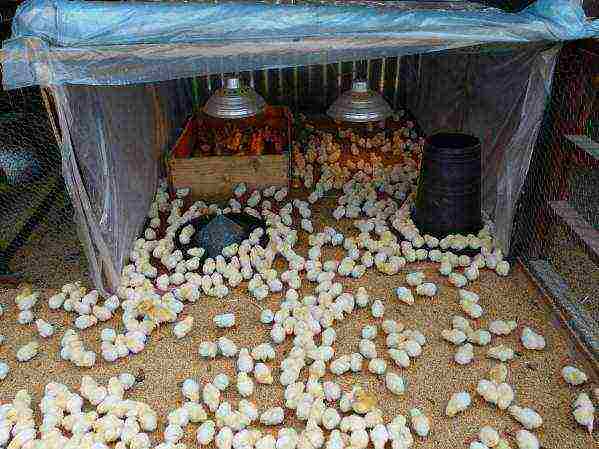 Newly hatched chicks in the pen
Newly hatched chicks in the pen
Is it better to grow with a hen or in an incubator?
Features of hatching chickens with a hen for beginners
How to grow a chicken from an egg at home without an incubator? Some experienced farmers prefer hatching eggs under a hen because it is a natural process.
It is worth noting that identifying a chicken that is ready to hatch will not be difficult. It is advisable to pay attention to the behavior of chickens. If suddenly the chicken does not get out of the nest for a long time or stays there for the night, then this probably indicates that the instinct of incubation has awakened in it.
But do not immediately lay eggs under it, it is advisable to observe the behavior of the individual for some time... It is necessary to let the chicken sit. A ready-made chicken for incubation, when pulled out of the nest, emits bubbling sounds and is torn with all its might back to incubation in the nest. In this case, raising day-old chicks at home will be quite economical.
Depending on the weight of the individual, 11 to 21 eggs are laid under it. The incubation area must be separated from the rest of the chickens. You can use a separate cage for the nesting site, or place the nest in a dark corner of the chicken coop.
Be sure to feed the henso that she does not die of hunger and exhaustion, which often happens. It is necessary to forcefully remove the chicken from the nest and feed and water it 2 times a day.
Chicks with a hen hatch in 20-21 days. Sometimes there are cases when a brood hen, without waiting for complete hatching, can throw the remaining eggs and go for a walk with the already hatched individuals. Therefore, to prevent these unpleasant problems, those individuals that have already hatched are placed in a box or in a warm place, a lamp is first installed above them.On days 22-23, the family unites.
Pros:
- Natural process;
- High survival rate;
- Chicks from the moment of hatching and in the subsequent period are together with the hen;
- Economical. This method will require fairly low financial costs.
Minuses:
- Long process;
- Low number of hatching chicks per season;
- There is a likelihood of pecking eggs by a brood hen during incubation;
- Chicks can be hatched in this way only once a season and only in warm weather.
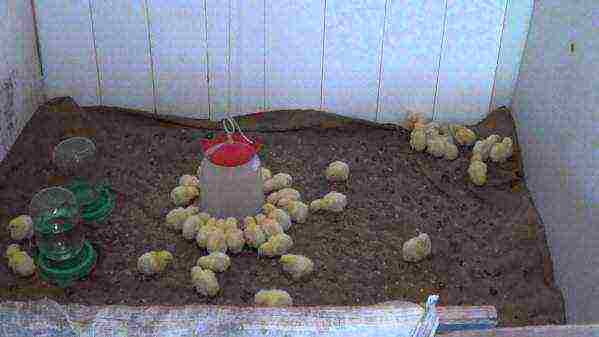 Feeding broiler chicks hatched in an incubator
Feeding broiler chicks hatched in an incubator
Features of raising chickens in an incubator at home and feeding them
Breeding chickens using an incubator is in great demand, and this is evidenced by the advantages of growing chickens after an incubator, among which the main ones should be highlighted:
- Beneficial use. In one season, the incubator is used up to 10 times;
- Simple use... This device is easy to handle, does not need to be fed, watered, and there is no need to worry that the brood hen will peck the eggs;
- You can lay from 50 eggs and more at a time;
- Breeding chicks all year round... These devices provide all the functions that provide output in winter and summer.
Depending on the function, incubators are mechanical, manual and automatic.
In a manual incubator, each egg is turned manually... The use of a mechanical incubator is almost the same as that of a hand held device. However, in this type of incubator, turning is carried out not for one egg, but all at once. In addition, compliance with humidity and temperature control in both types of devices lies entirely with the owner.
But devices with automatic turning of eggs greatly simplify the life of the farmer, because they have a digital thermostat installed in them. During the laying of eggs, it is required to set a certain temperature, and it remains stable during the subsequent incubation period.
If the temperature regime rises or falls sharply, then the mechanism makes a sharp sound... In addition, the eggs are turned every hour, which prevents the embryo from sticking to the shell, and increases the percentage of chick survival. However, these devices are expensive. But this is the only way you can raise healthy chickens.
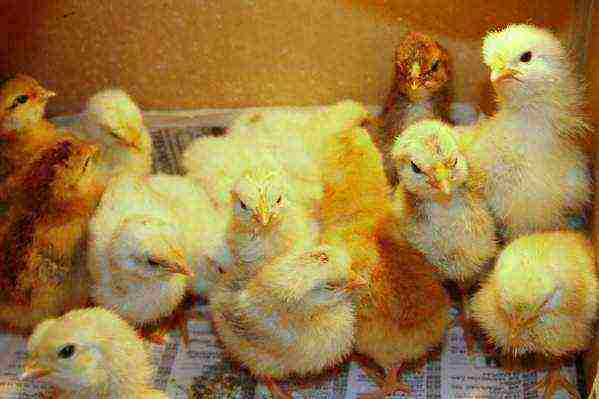 Correct management of newly hatched broiler chicks
Correct management of newly hatched broiler chicks
Conditions of detention
Premises
Keeping chickens out of the hatchery at home is easy. Remember a few rules for caring for a chicken house:
- An important condition of the room is cleanliness. Be sure to clean up the place where the chicks are kept every day, remove garbage, uneaten food. Otherwise, infections can quickly appear in an uncleaned room;
- If litter is available in the house, it is regularly changed. It must always be clean and dry;
- It is not advisable that a large number of poultry be present in the place of detention. It is important to provide young animals with free space so that they can walk freely, run, fully exercise all motor functions;
- Number of livestock keeping directly depends on the area of the place for keeping chicks.
You should not keep chicks indoors all the time. Regularly, you need to take the bird population outside for walking, but preferably at 2 months of age. Fresh air, obtaining additional green fodder are the main conditions for the full functioning of all the poultry's digestive organs.
Light
The second important condition for keeping chicks is light. The length of daylight hours depends on the age of the young.
From the first days of a chicken's life, it is necessary to maintain the duration of daylight hours at least 18 hours... This is then reduced to 10 hours before the chicks reach 4 months of age.
These indicators do not depend on the type of chicken breed.In addition, it does not matter what the poultry is grown for - for eggs or meat, this indicator should remain unchanged. The duration of daylight hours in winter can be maintained by the presence of additional lighting in the room where the individuals are kept.
Temperature for breeding healthy individuals
Temperature parameters depend on the age of the bird:
- For diurnal individuals up to 5 days of age, a suitable temperature regime in the room is considered to be up to +32 degrees Celsius;
- With the onset of 6 days of life and up to 9 days, the temperature gradually decreases to +28 degrees Celsius;
- From day 10 to day 20, the temperature regime is reduced by another 3 degrees +25 degrees Celsius;
- In the subsequent period, the temperature should be maintained from +20 degrees to 24 degrees Celsius.
Maintaining an optimal temperature level can be ensured by using lamps for lighting. In winter, additional heaters can be installed.
Food
What to give in the first days of life
Chick feeding should be started immediately after hatching.... But still, it is worth waiting for a while for them to dry out, to get a little stronger.
A small amount of corn grits should be poured into a feeder with a flat base or simply on the bottom of the box. This cereal has a fine structure, so this food will be most suitable for newborn chicks.
Do not give crushed yolk to newborn chickens. This product has a high fat content. Also, many veterinarians note that this food does not exert proper stress on the muscular structure of the stomach of a newborn chicken. As a result, the formation and structure of the walls of the stomach is disrupted. If roughage is given after this meal, it can cause indigestion.
Feeding day old chicks
The diet of diurnal individuals, in contrast to newly hatched chicks, is already more varied. In addition to corn grits, individuals can be given other types of feed:
- Semolina;
- Barley groats;
- Millet;
- Ground oat flakes;
- Wheat groats.
The feeding process for day old chicks should be done every two hours.... Feed should be given in small portions. It is advisable not to mix cereals, otherwise some individuals will begin to choose their favorite food and will only eat it. Therefore, it is best to give feed mixtures individually and dry.
For full-fledged growth and development, chicks should be given other components in addition to cereals. For young individuals, cottage cheese is very useful. Thanks to this product, the body of chickens is saturated with nitrogenous substances and calcium. Cottage cheese can be given from 2-3 days after the emergence of chicks in the morning, pre-mixing with cereals.
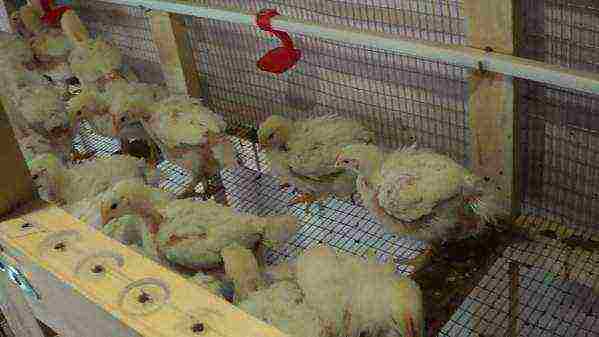 Organization of feeding of grown chickens
Organization of feeding of grown chickens
It is worth remembering that dairy products provide high value for babies... Instead of water, you can pour whey, liquid kefir into the drinker. On the third day, individuals can be fed with greens. For food, you can use plantain, clover, dandelion, nettle, biting. On the 5th day, green onions should be introduced. Green onions have a beneficial effect - they provide high protection for the body against various intestinal diseases.
Weekly
Individuals of one week of age can already begin to give a mixture of corn, barley, oat and wheat groats. The cereals are mixed in equal proportions - 1: 1.
Additionally, chopped herbs and dairy products can be added to the mixture. During this period, individuals can already be fed less often, but the portions should be large. Up to 4-5 feedings should be received per day.
Period
From a month or more, chicks are released outside for walking. For this reason, the diet during this period is green. Through the use of herbs and other greens, individuals receive the vitamins necessary for their growing body.
Besides coarsely ground grain is introduced into the diet of individual layers... From a month and a half, adults should eat whole grains. You can give meat and bone meal and food waste.
How to determine the gender of a chicken: chicken or rooster?
In the egg
How to identify a chicken from a rooster in an egg? Not many poultry farmers will be satisfied when, after hatching, the percentage of males will be almost 80-90%. Therefore, in these cases, the method of determining the sex of a cock or a chicken by egg is used. It would seem that this task is difficult and almost impossible, but this is far from the case.
To determine the sex of the egg, recommendations will help:
- First you need take an egg in your right hand, while the sharp end of the egg should be directed upward;
- Further run your left finger along the top of it;
- If a ring and tubercles are observed at the upper end, then these criteria indicate that a cockerel will appear. If the top of the egg has a smooth structure - a chicken.
 Hatching chicks with a brood hen
Hatching chicks with a brood hen
At day-old
How to distinguish a chicken from a cockerel at one day of age? At one day of age, sexual characteristics do not appear at all clearly, so it is quite difficult to determine the sex. Females usually have more luxuriant plumage., but males, on the contrary, are scarce, in some places they can be without fluff.
At 2 months
How to tell a rooster from a chicken at 2 months old? At this age, gender can be determined using several methods:
- By plumage... Individuals with abundant plumage are females, and those with poor plumage are males;
- By this age, the cockerels have a comb, the beard turns red, and the face is rounded;
- In cockerels, legs become longer, spurs can already be seen on them;
- In males, overgrown plaits appear on the tail.
At 3 and 4 months
How to distinguish a rooster from a chicken at 3 or 4 months At the age of 3 months, sex determination of individuals is much easier, in roosters you can see the following external characteristics:
- The scallop becomes bright in color;
- The crest, beard and earrings become large;
- The legs become high;
- Spurs are already clearly visible on the legs;
- The tail has long braids.
Methods for determination in poultry farms
In addition to traditional methods for determining the sex of chickens, there are other methods that are usually used in poultry farms. These methods help to determine the gender with the greatest probability.
Cytogenetic way
How can a cockerel be distinguished from a chicken by this method? This method is based on age determination by the karyotype of a fast-acting feather pulp cell. Usually in males who are not even a month old, the Z chromosome acts as the longest metacentric.
In females, the number of these chromosomes is 10 times less; W-chromosomes - submetacentric - predominate in their bodies. If, during the analysis, it is found that the Z-chromosome is present in the body in a single copy, then this is a chicken, if there are a lot of these chromosomes, then a cockerel.
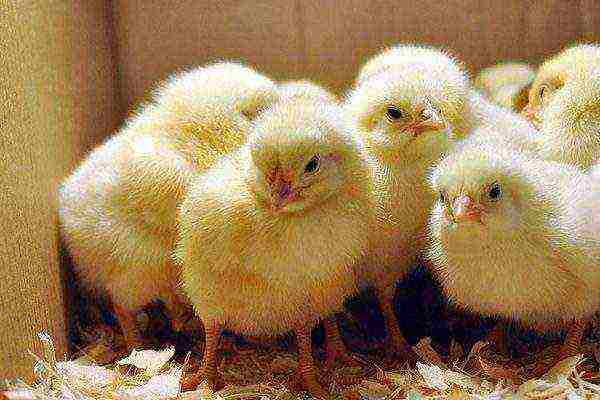 Sex determination of chicks by different methods
Sex determination of chicks by different methods
DNA
This method, how to distinguish chickens from females, allows you to determine the sex of the chicks with the greatest probability. It is based on blot hybridization of blood DNA with a primer.
The juvenile can be identified with high accuracy using the analysis of samples or whole blood, washed erythrocytes. The disadvantages of this method include high cost and labor intensity.
On the wings
Determining gender using this method:
- The first way is inspecting the color of the wings... At the age of 2-3 days, the wings of the chicks are examined - in males they are slightly lighter than in females;
- The second way is in counting feathers... It is necessary to pull the wing of the chick and spread it. Chickens fledge first, for this reason 6-7 primary feathers are large in size, unlike others. But males have all the same feathers.
To size
The sex of the chicks is determined depending on their size. Typically, a high-precision balance is used for this method.If an individual has a large enough mass for its age, then it is a cockerel. If the mass is small, then this is a female. Usually the difference in weight is about 5 grams.
How to tell the sex of a hen by color?
Determination of sex by color of plumage is mainly used for purebred individuals:
- Running shoes... At about the age of 1 day, sexual characteristics are determined: beige is typical for females, and white for males;
- Autosex breeds... Chickens have monochromatic colors - gray, white, black, and males have stripes;
- Brahmas... Females have distinct stripes on the back and points on the head. Males also have stripes and dots, but they are slightly blurred;
- Rhode Island and New Hampshire breeds. On the second day after hatching, dark spots and stripes can be seen on the head of females; males do not have these characteristics;
- Adler silver. Females are yellow in color, and males are lemon with a black stripe on their heads.
Japanese method
This method of sex determination of chicks is used in many poultry farms. The accuracy of this method is almost 95%. However, to implement this method, you need to have special skills.
Before you start sex determination using this method, it is worth understanding the structure of the chicks' genitals and finding out their differences.
Males can be separated from females by detecting a tubercle in the anus, which is absent in future chickens:
- First of all, the chick's cloaca is cleaned of traces of droppings;
- Next, the individual should be taken in the palm of your hand, turned over, paws apart so that the cloaca is clearly visible;
- The hole must be pushed apart, at the same time you need to press on the abdomen. As a result of these manipulations, the internal structure of the cloaca will be clearly visible.
External differences between the cloaca of females and males:
- In females, the cloaca looks like a neat nodule without bulges;
- In males, a genital tubercle is quite often found.
To avoid unpleasant consequences, this method should only be carried out by an experienced poultry breeder or farmer.
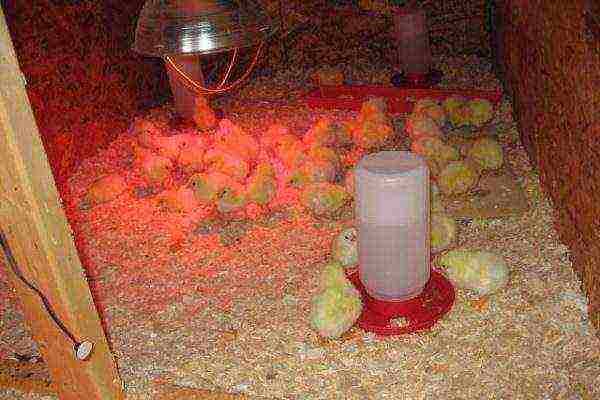 Arranging a place for newly hatched chicks
Arranging a place for newly hatched chicks
Reflex
how to distinguish chicks by sex using this method? This gender determination method is performed in two ways:
- You should take the chick by the scruff of the neck and look behind the legs for a while. Usually chickens try to curl their legs, and clench the claws. At the same time, it raises the paws a little. And the bettas, on the contrary, do not twist their legs, and do not move them, they hang in an even position;
- You can, on the contrary, take the chick by the legs and look behind the position of the head. Chickens usually lift their heads up., and the cockerels, on the contrary, hang without moving.
How to distinguish a cock from a chicken by voice?
Usually this method is used by the Orpington and Cochin peoples. The voice of males is the most coarse, similar to a quack. In females, on the contrary, the voice is softer, they mostly squeak. This method does not always allow you to accurately determine the sex characteristics of individuals. It is mainly used by experienced poultry farmers.
How do you determine your age?
Usually the age of chicks is determined by the plumage. It is advisable to remember the features of plumage depending on age:
- Between 8 and 12 days of age, feathering appears in the shoulder area;
- In the period from 12 to 16 days, feathers appear on the crop and breast;
- In chicks of three weeks of age, the first molt is observed, while all the fluff falls out of the tail;
- At the end of the fifth week, flight feathers grow, and feathers appear on the back of the body;
- At six weeks of age, the head and lower body are covered with a feather;
- Full plumage is observed at the age of 3 months.
Diseases of chickens
Chickens, as well as chicks of other bird species, are susceptible to various diseases. The following diseases are most common:
- Avitominosis;
- Poisoning;
- Digestive disorders;
- Salmonellosis;
- Coccidosis;
- Typhus and many others.
In order to properly treat diseases, it is worth knowing what symptoms are characterized by diseases in chickens.
Diarrhea in chickens
Why broilers vilify chickens is sometimes quite difficult to figure out. Below, let's try to figure out and understand all the reasons for this phenomenon.
White diarrhea in broilers: can it be cured?
Quite often, chickens develop white diarrhea. It is also called pullorosis. This disease usually occurs in an acute form and quickly affects the fragile intestines of chickens. The causative agent of this disease is a bacillus called salmonella. The disease usually spreads at a high rate, in a few days almost all birds can get sick.
 White diarrhea in broiler chicks
White diarrhea in broiler chicks
How to cure diarrhea in chickens? For prophylaxis, you need to clean the room of debris, disinfect everything. It is also imperative to check the room temperature and ventilation.
Recovered individuals are subject to destruction. Meat from sick birds should not be eaten.
Yellow diarrhea in broilers: why it occurs and how to treat it?
This diarrhea can occur during infectious diseases, as well as if the conditions of detention are not observed. Sometimes yellow droppings are seen in Gumboro disease. In these cases, an examination and testing are carried out.
Besides yellow diarrhea can result from stress, hypothermia, due to poor quality feed. In these cases, folk remedies are used for treatment and the premises are disinfected.
 Yellow diarrhea in chickens
Yellow diarrhea in chickens
Bloody diarrhea in chickens: a symptom of what diseases?
Bloody diarrhea usually occurs with coccidiosis. This disease is dangerous and often leads to the death of the entire bird population. This disease occurs due to poor hygiene, namely, untimely cleaning of the room. This disease affects the intestines. In addition to diarrhea, the following conditions are observed:
- Loss of appetite;
- Lethargy, inactivity;
- Tousled plumage;
- Impurities of blood and mucus appear in the droppings.
How to treat if chickens have bloody diarrhea? For treatment and prevention, it is necessary to clean and disinfect the premises in a timely manner, vaccinate and give the appropriate chemicals.
Light brown diarrhea in broiler chickens and its treatment
Broilers have brown diarrhea with eimeriosis. This disease is caused by various parasitic protozoa that accumulate in the intestines of chickens or hens. Infection usually occurs through food, dirty bedding, gadfly.
Symptoms of the disease:
- Individuals sit in one place with closed eyes;
- Tousled plumage;
- The wings are hanging to the floor;
- Lack of appetite;
- Brown diarrhea with mucus.
The disease is determined during the study. Treatment is best done at an early stage. For treatment, drugs are used - coccidiostatics.
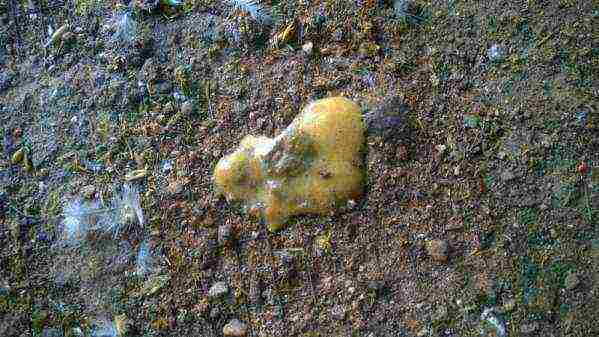 Light brown diarrhea in chickens
Light brown diarrhea in chickens
Chickens vilify green
Green diarrhea can occur with pasteurellosis disease. In this case, examinations, analyzes are carried out. If the diagnosis is confirmed, then appropriate treatment is prescribed.
In the absence of pasteurellosis, green diarrhea can cause poor-quality expired feed. In this case, the treatment is carried out using adsorbing agents (activated carbon). Suspicious feed must be disposed of and only high quality feed provided.
 Green diarrhea in chickens
Green diarrhea in chickens
Worms
Chickens often have such an unpleasant disease as helminthiasis. This condition poses a particular danger, and in almost 50% of cases, if not treated promptly, it leads to death. Signs of worms in chickens are severe emaciation.
The main danger of this disease is that it affects all individuals in the same room. Worms are excreted along with the droppings of affected individuals and, together with food, enter the body of healthy individuals.
What to do if chickens develop worms? In order to save the entire livestock of birds, you need to plant infected chicks in time, clean the room, remove all bedding and disinfect everything. Infected individuals should be given antihelminthic drugs and nutritious food. Medicine for worms in chickens should be given as early as possible.
Disease prevention
Preventive measures for various diseases of chickens include the following recommendations:
- Timely cleaning and disinfection of the premises saline solutions, caustic soda, bleach;
- Compliance with the density of livestock in the poultry house. It is desirable that the number of chicks in one room be moderate;
- Quality feed with a high nutrient content;
- It is imperative to equip the ventilation of the room;
- Compliance with the temperature regime of the room;
- Soldering birds with drugs against infectious diseases;
- Timely vaccination.
Breeding chickens is a laborious process that requires a lot of responsibility. In order for the livestock to be healthy, it is imperative to follow all the rules of keeping. The main condition for the full growth and development of chicks is care and attention!
Now you know how to raise chickens at home, how to treat chickens, what to do if chickens develop worms, and how to treat diarrhea in chickens and adults. Follow all recommendations and watch out for chicks.
And a video on how to feed chickens:
 The incubation period is a crucial time, you need to control the temperature and humidity on a daily basis, as well as air and turn the eggs in a timely manner. Beginners are intimidated by this responsibility, so we present a set of rules describing the hatching of chickens in an incubator at home. Please note that all recommendations are mandatory, otherwise some of the chicks will die in the bud.
The incubation period is a crucial time, you need to control the temperature and humidity on a daily basis, as well as air and turn the eggs in a timely manner. Beginners are intimidated by this responsibility, so we present a set of rules describing the hatching of chickens in an incubator at home. Please note that all recommendations are mandatory, otherwise some of the chicks will die in the bud.
Selection of eggs
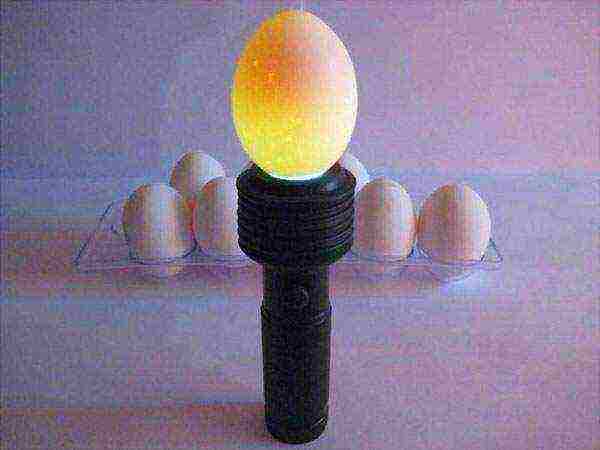 Success in business depends not only on the efforts of the owner, but also on the quality of the eggs. Therefore, before hatching chicks correctly in the incubator, pay attention to their selection. Interestingly, the process of hatching chickens must be started with the chicken. Indeed, you need to make sure that she is not sick with anything and does not have any genetic diseases. Otherwise, the genetics of the chicks will also be disrupted. Next, we pay attention to the eggs, the quality indicators are as follows:
Success in business depends not only on the efforts of the owner, but also on the quality of the eggs. Therefore, before hatching chicks correctly in the incubator, pay attention to their selection. Interestingly, the process of hatching chickens must be started with the chicken. Indeed, you need to make sure that she is not sick with anything and does not have any genetic diseases. Otherwise, the genetics of the chicks will also be disrupted. Next, we pay attention to the eggs, the quality indicators are as follows:
- odorless, possible deviations - moldy, pungent, grape, putrid and other odors;
- freshness - with a shelf life of no more than 5-7 days;
- correct storage - at a temperature not lower than 10-12 ° C, those who have been in the refrigerator must be disposed of;
- optimal shape - for chicken eggs it is an oval shape slightly narrowed on one side, without outgrowths, indentations. Spherical or overly elongated are also subject to marriage;
- no damage - carefully check the shell for cracks and dents, dirty dried spots are permissible only in small quantities;
- optimal weight (50-60 g) - weak chicks often appear from small ones, and large ones turn out to be with two yolks.
The egg shell is porous so that air can penetrate through it, and also has its own microflora. It is strictly forbidden to wash or wipe the eggs.
When checking eggs, they must be scanned with a special device - an ovoscope. When translucent, pay attention to the differences in the shades of the content. You need to find the yolk and air chamber. The yolk should be in the center or slightly close to the blunt end. You cannot take an egg in which the yolk is adjacent to the inside of the shell. The air chamber must be at the blunt end. The normal volume for her is about a teaspoon. An egg with a small air chamber will not work.
Defective
During selection, as well as during the hatching period of chicks in an incubator at home, it is necessary to inspect the contents and dispose of eggs with developmental pathologies.Before hatching chicks in the incubator, remember the possible irregularities during embryo maturation.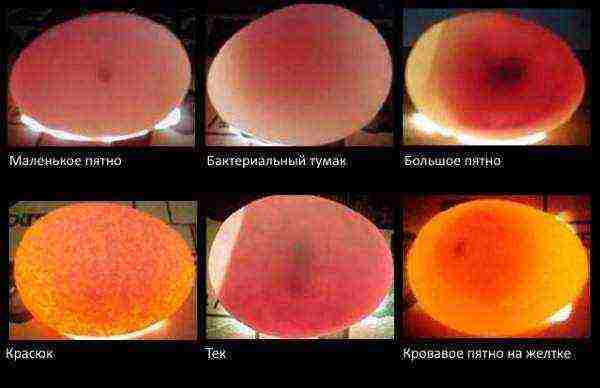
Stains
Usually appear under the shell, caused by various bacteria. The spots can be of various shades and sizes.
Tumac bacterial
A type of infection by putrefactive bacteria in which the protein liquefies and becomes greenish. At the same time, the egg is opaque.
Drying
With this pathology, the yolk floats and dries to the inside of the shell. At the same time, the egg may have a pungent smell.
Bloody stain
In this case, blood inclusions are present on the surface of the yolk or in the protein.
Krasyuk
During ovoscopy, the contents look uniform with a reddish tint. The yolk and air chamber are not visible.
Tyok
Pathology develops after damage to the shell membrane during storage for more than one day.
With any of these pathologies, the egg must be disposed of; you cannot fry or cook them for eating.
Incubation period
 From the moment the eggs are laid, their incubation begins. The incubation period ends after the last chick has bite. Breeding chicks in an incubator differs from breeding goslings by the timing of incubation, maintaining temperature and humidity.
From the moment the eggs are laid, their incubation begins. The incubation period ends after the last chick has bite. Breeding chicks in an incubator differs from breeding goslings by the timing of incubation, maintaining temperature and humidity.
Loading eggs into the incubator
Before leaving chicken eggs in the incubator at home, prepare them and the incubation chamber. The inner chamber of the device is thoroughly disinfected and ventilated. While preparing the incubator for hatching at home, it is best to leave the eggs at room temperature for 8 hours to warm them up gradually and evenly. It is advisable to mark the blunt and sharp end with a pencil with a cross or zero. This will help in controlling the overturning of the masonry.
Controlling incubation conditions
The temperature and humidity in the chicken egg incubator must be controlled every hour. Even a slight change (0.5-1 ° C) will lead to a slowdown in the growth or death of embryos. After loading the eggs, the temperature should rise to 37 ° C in 3-4 hours. During the entire incubation period, the temperature and humidity will change several times.
Incubation schedule
The maturation of embryos is divided into 4 stages, they are briefly given in the table of incubation of chicken eggs in an incubator.
Stage 1 - from 1 to 7 days... The heart, circulatory system and the rudiments of internal organs are being formed. During this period, ventilation is not required, but by the end the embryo already needs oxygen. The most optimal temperature is 37.8 ° C. Humidity is maintained around 55%. Eggs need to be turned every 6 hours, that is, 4 times a day. At the same time, it is highly discouraged to open the incubator.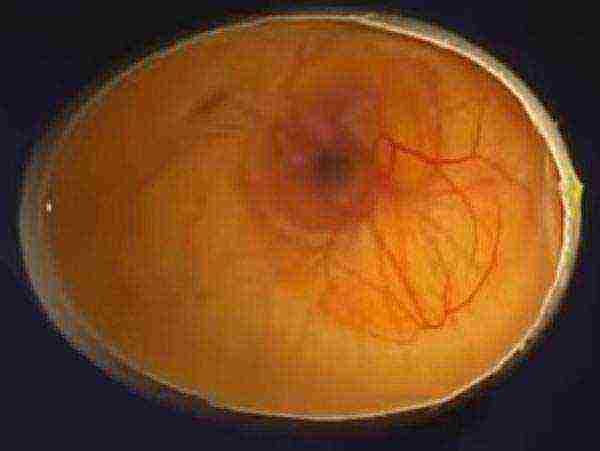
It is better to equip the incubator with a tray with automatic egg turning.
Stage 2 - from 8 to 14 days... During this time, the skeleton and beak are formed in the embryo. The temperature is the same as in the previous period, but the humidity is reduced in stages over 3-4 days to 45%. You need to change the position of the eggs every 4 hours - 6 times a day. It is also required to air the eggs for oxygen supply, this must be done 2 times a day for 5 minutes.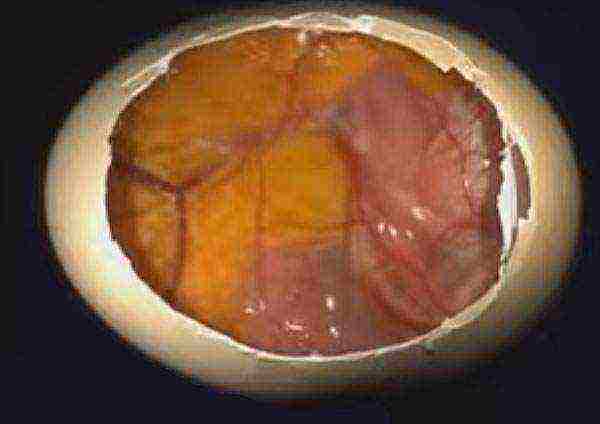
Stage 3 - from 15 to 18 days. It is also necessary to turn the eggs 6 times a day, while the airing is increased to 15-20 minutes, also 2 times a day. The humidity is increased to 50%, the temperature is made the same. At the end of the period, with successful hatching, the chicks begin to make barely audible sounds and turn over in the egg.
Stage 4 - from 19 to 21 days. First of all, they stop turning the eggs, the chickens are strong enough and do it on their own. Reduce airing time to 5 minutes twice a day. The humidity is increased to 65%, the temperature is reduced to 37.3 ° C. At the end of this period, the chicks hatch in the incubator.
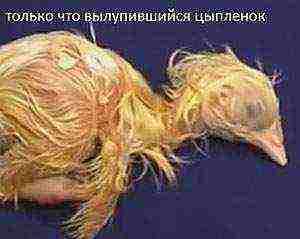 If you follow all the above rules and monitor the operation of the devices, then the brood will turn out to be numerous. From small eggs, chicks are selected first.After hatching, the chicks are allowed to dry out, gain strength, after which the chicks from the incubator move under the hen or heater. Conditions in it are not suitable for chicks. After all chicks hatch, the incubator is cleaned and disinfected.
If you follow all the above rules and monitor the operation of the devices, then the brood will turn out to be numerous. From small eggs, chicks are selected first.After hatching, the chicks are allowed to dry out, gain strength, after which the chicks from the incubator move under the hen or heater. Conditions in it are not suitable for chicks. After all chicks hatch, the incubator is cleaned and disinfected.
Control and probable complications
Even the highest quality incubators and responsible owners are not immune to emergencies. To protect yourself and your eggs from power outages, purchase incubators with a spare power source. If the offspring overheat, you need to open the incubator for a while and cool the eggs. In case of hypothermia, you can cover the camera for 2-3 hours with hot water pads. Slight fluctuations in temperature and humidity will not kill the young, but all these procedures must be carried out immediately.
Of course, the egg grooming schedule must be observed, and you also need to closely monitor how many days the chicks hatch in the incubator. The noughts and crosses on the eggs should help you navigate the turning of the eggs.
It is also necessary to monitor the development of the chicks with an ovoscopy. All defective eggs must be disposed of immediately. It is recommended to perform transillumination on the 6th and 11th day. On the sixth day, the blood vessels and heart should be visible. On the eleventh day, the egg on the sharp side should darken.
Breeding chicks in a simple incubator - video

